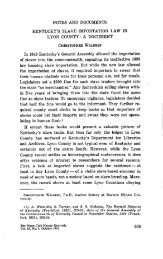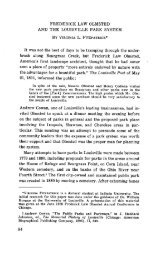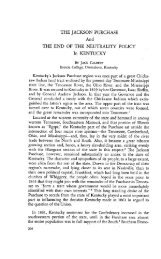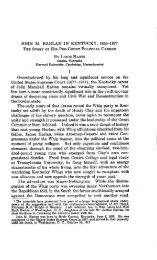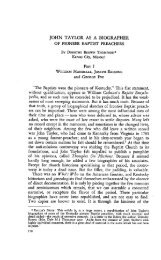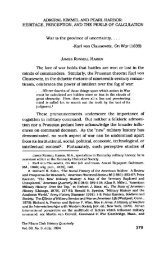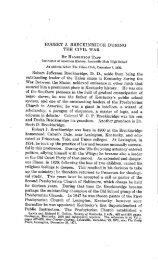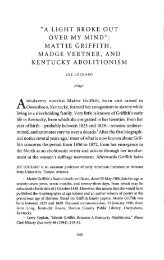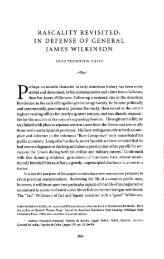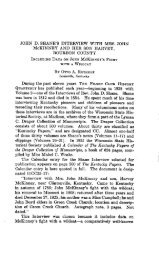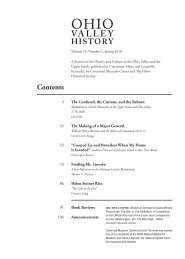Eskippakithiki, The Last Indian Town in Kentucky - The Filson ...
Eskippakithiki, The Last Indian Town in Kentucky - The Filson ...
Eskippakithiki, The Last Indian Town in Kentucky - The Filson ...
You also want an ePaper? Increase the reach of your titles
YUMPU automatically turns print PDFs into web optimized ePapers that Google loves.
Voh 6] <strong>The</strong> <strong>Filson</strong> Club History Quarterly 365<br />
which the French take when they _resort to Carol<strong>in</strong>a. Be<strong>in</strong>g on<br />
this "route" as well as on the Warriors' Trace from Ohio to Carol<strong>in</strong>a,<br />
as shown on Evans' map of 1755, we have no alternative but<br />
to believe that this census is of our <strong>Eskippakithiki</strong>. Two hundred<br />
men implies from at least eight hundred to one thousand people.<br />
This town was then the metropolis of <strong>Kentucky</strong>, of Shawnee<br />
<strong>Kentucky</strong>, of Canadian <strong>Kentucky</strong>, of Iroquoian <strong>Kentucky</strong>, when<br />
all Kentuckians did homage to Louis, the Grand Monarque of<br />
France, serenely oblivious, <strong>in</strong> the distractions of his pleasure-seek<strong>in</strong>g<br />
court, of the huddle of dusky savages who, <strong>in</strong> the deep forests<br />
of the New World, were achiev<strong>in</strong>g life and security under the<br />
psychologic <strong>in</strong>fluence of his potent name; and did homage also to<br />
the dusky diplomats and warriors of the "Long House" of the<br />
]roquois, <strong>in</strong> the far away valley of the Mohawk, more ' frightful<br />
and more potent, <strong>in</strong> time and place, than the Grand Monarque.<br />
<strong>Kentucky</strong>'s present metropolis bears K<strong>in</strong>g Louis' name, but<br />
acknowledges no feudal sovereign, no swarthy overlords.<br />
ThE MURDEa OF THE SENECA CHIEF: A band of young Shawnees,<br />
at the time liv<strong>in</strong>g on the upper Allegheny, <strong>in</strong> 1734 killed a<br />
chief of the Senecas, br<strong>in</strong>g<strong>in</strong>g upon themselves the wrath of the<br />
Iroquois and the Pennsylvania government. John and Thomas<br />
Penn, <strong>in</strong> a letter to the Senecas dated July 29, 1735, say that they<br />
understand that the Shawnees who killed the chief came to the<br />
Allegheny "about four years s<strong>in</strong>ce," . . . "from the westward,<br />
or southward of the Ohio."2 This sounds like they came from<br />
<strong>Eskippakithiki</strong>, as it is the only Shawnee settlement that could be<br />
so described at that time. <strong>The</strong> murderers fled at once down the<br />
Ohio and, as they would not have dared to stop at the newly<br />
founded Lower Shawnee <strong>Town</strong> at the mouth of the Scioto, because<br />
it was too close to their enemies, they doubtless took refuge<br />
with their k<strong>in</strong> at <strong>Eskippakithiki</strong>, who had no love for the Senecas.<br />
THE CATAWBA SIEGE: This affront to the Scnecas, the<br />
strongest member of the Iroquois League at the time, may have<br />
been the cause of the Catawba attack on Eskippakitlfiki <strong>in</strong> 1736,<br />
two years later. Afraid to attack a town under French protection.<br />
because of their own vulnerability along the St. Lawrence French<br />
frontier, they may have sicked onto it the Catawbas, who were<br />
not only historically anti-French but were too far from the seat<br />
of French power to have any political qualms. Whatever the<br />
cause, the Catawbas fell on <strong>Eskippakithiki</strong> <strong>in</strong> 1736 and probably



